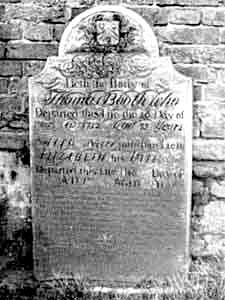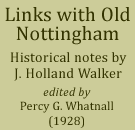< Previous | Contents | Next >
Booth's tombstone, St. Nicholas' churchyard
 |
BOOTH was a poacher and his disagreeable epitaph is perhaps in keeping with his disagreeable life. The only reason for remembering him is that his story and his pursuits link us up with a different state of affairs from those which now exist, and shows us conditions of life in Nottingham not so very long ago which makes us amazed at the changes which have taken place in the last two hundred years.
As one dodges the traffic in Nottingham streets or waits anxiously for a chance to cross its roads, it is hard to believe that less than a hundred and fifty years ago Nottingham was little more than an agricultural community and was surrounded by so primitive a district that so late as the year 1800 a man named Morley shot a wild stag in what is now known as Sneinton Elements.
Nottingham Park enclosed a herd of deer, part of which was sold in 1717, and carted stags were hunted in the Park as late as 1798.
These deer were a temptation to the ne’er-do-wells of the town, and were the quarry of Thomas Booth.
One stag in particular which couched where the present estate offices are built attracted Booth’s attention by its size and condition, so that he determined to have it, keeper or no keeper.
To secure his end he enlisted the services of a friend, who discharged a gun half-way up the slope now called Tattershall Drive. Off rushed the keepers to capture this miscreant, and while they were chasing him Booth shot the coveted stag and dragged its body into Brewhouse Yard, in which delectable neighbourhood (free from police control in those days) he was quite safe.
This escapade, together with his epitaph, have won for Thomas Booth a notoriety which emphasises Shakespeare’s dictum that the evil men do lives after them.
